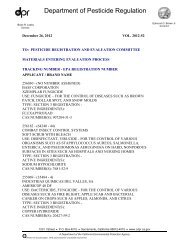Dichlorvos (DDVP) Risk Characterization Document - California ...
Dichlorvos (DDVP) Risk Characterization Document - California ...
Dichlorvos (DDVP) Risk Characterization Document - California ...
You also want an ePaper? Increase the reach of your titles
YUMPU automatically turns print PDFs into web optimized ePapers that Google loves.
D. CHRONIC TOXICITY AND ONCOGENICITY<br />
Summary: <strong>DDVP</strong> caused the inhibition of plasma, erythrocyte, and brain ChE activities. Other nononcogenic<br />
effects included hepatocellular lesions (vacuoles in the cytoplasm, cell swelling,<br />
prominence of cell membranes), reduced body weight, emesis, salivation, and ataxia. Oncogenic<br />
effects observed in rats and mice were pancreatic adenoma; mononuclear leukemia; mammary gland<br />
carcinomas, fibroadenomas, and adenomas; forestomach papillomas and carcinomas; and pituitary<br />
adenomas. <strong>DDVP</strong> also increased tumor growth rate in rats given leukemia transplant. The chronic<br />
toxicity of <strong>DDVP</strong> was studied in rats, mice, and dogs and is summarized in Table 9.<br />
Dietary - Rat<br />
Osborne-Mendel rats (10/sex/control, 50/sex/treated group) were fed <strong>DDVP</strong> (94% purity; 0, 150, or<br />
1000 ppm) in the diet daily for 80 weeks (NCI, 1977a). After 3 weeks on the 1000 ppm diet, the<br />
dosage of <strong>DDVP</strong> in this group was reduced to 300 ppm because of toxicity (tremors, rough coats, and<br />
diarrhea). The estimated dosages for 150 and 300 ppm were 7.5 and 15 mg/kg-day, respectively,<br />
based on the assumed consumption rate of 5% body weight. In the second year of the study, clinical<br />
signs (rough coat, epistaxis, hematuria, alopecia, dark urine, palpable masses, bloating or abdominal<br />
distention) were observed in both the control and treated groups. The average body weights of the<br />
high-dose (300 ppm) rats were lower than those of the other groups, an approximate difference of 50<br />
grams throughout the study (estimated from graphed data). The NOEL for reduced body weight was<br />
150 ppm (7.5 mg/kg-day). The possible treatment-related findings were increased incidences of<br />
macrophage accumulation in the lungs, myocardial fibrosis, and thyroid follicular cell hyperplasia.<br />
There was no evidence of oncogenicity. This study was unacceptable to DPR according to FIFRA<br />
guidelines (no analysis of diet, no individual data, inadequate number of concurrent controls, and<br />
staggered start for low and high doses with 4-week interval). The EPA classification of this study was<br />
supplementary.<br />
CD rats (25/sex/group) were fed <strong>DDVP</strong> (93% purity; 0, 0.1, 1, 10, 100 or 500 ppm) in the diet daily for<br />
2 years (Witherup et al., 1967). There was a 22-80% loss of the test material due to volatilization and<br />
hydrolysis. The average dosages were 0, 0.0013, 0.013, 0.13, 1.2, and 8.0 mg/kg-day based on the<br />
body weight and food consumption rates for both sexes at week 104, and the average concentrations<br />
of <strong>DDVP</strong> in the diet 12-16 hours after preparation of the diet. In the 100 ppm group, there were<br />
statistically significant (p @ 0.05) decreases of 79% (of control values) for both plasma and<br />
erythrocyte ChE activities in the males, and of 95% for plasma and 82% for erythrocyte ChE in<br />
females. The reduction in brain ChE activity to 85% of control values in the 500 ppm group was not<br />
statistically significant. Histopathological examination of tissues from rats fed 500 ppm showed liver<br />
cells with diffused fine vacuoles in the cytoplasm, occasionally fat vacuoles, and swelling of the cell.<br />
The NOELs were 100 ppm (1.2 mg/kg-day) for liver effects and 10 ppm for plasma and erythrocyte<br />
ChE inhibition, and greater than 500 ppm (> 8.0 mg/kg-day) for brain ChE inhibition. This study was<br />
considered unacceptable to DPR according to FIFRA guidelines (inadequate numbers of animals at<br />
risk, weekly instead of daily preparation of diet, inadequate histopathology, as only major organs were<br />
examined, and blood chemistry). The EPA classification of the study was supplementary.<br />
31
















